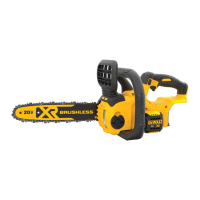ENGLISH
5
• Felling Back Cut - The final cut in a tree felling operation made
on the opposite side of the tree from the notchingcut.
• Front Handle - The support handle located at or toward the
front of the chainsaw.
• Front Hand Guard - A structural barrier between the front
handle of a chain saw and the guide bar, typically located
close to the hand position on the fronthandle.
• Guide Bar - A solid railed structure that supports and guides
the sawchain.
• Guide Bar Scabbard - Enclosure fitted over guide bar to
prevent tooth contact when saw is not inuse.
• Kickback - The backward or upward motion, or both of the
guide bar occurring when the saw chain near the nose of the
top area of the guide bar contacts any object such as a log
or branch, or when the wood closes in and pinches the saw
chain in thecut.
• Kickback, Pinch - The rapid pushback of the saw which can
occur when the wood closes in and pinches the moving saw
chain in the cut along the top of the guidebar.
• Kickback, Rotational - The rapid upward and backward
motion of the saw which can occur when the moving saw
chain near the upper portion of the tip of the guide bar
contacts an object, such as a log orbranch.
• Limbing - Removing the branches from a fallen tree.
• Low-Kickback Chain - A chain that complies with the
kickback performance requirements of ANSI B175.1–2012
(when tested on a representative sample of chain saws.)
• Normal Cutting Position - Those positions assumed in
performing the bucking and fellingcuts.
• Notching Undercut - A notch cut in a tree that directs the
tree’sfall.
• Rear Handle - The support handle located at or toward the
rear of thesaw.
• Reduced Kickback Guide Bar - A guide bar which has been
demonstrated to reduce kickbacksignificantly.
• Replacement Saw Chain - A chain that complies with
kickback performance requirements of ANSI B175.1–2000
when tested with specific chain saws. It may not meet the
ANSI performance requirements when used with othersaws.
• Saw Chain - A loop of chain having cutting teeth, that cut
the wood, and that is driven by the motor and is supported by
the guidebar.
• Ribbed Bumper - The ribs used when felling or bucking to
pivot the saw and maintain position whilesawing.
• Switch - A device that when operated will complete or
interrupt an electrical power circuit to the motor of the
chainsaw.
• Switch Linkage - The mechanism that transmits motion
from a trigger to theswitch.
• Switch Lockout - A movable stop that prevents the
unintentional operation of the switch until manuallyactuated.
Additional Safety Information
WARNING: Never modify the power tool or any part of it.
Damage or personal injury couldresult.
WARNING: ALWAYS use safety glasses. Everyday
eyeglasses are NOT safety glasses. Also use face or dust
mask if cutting operation is dusty. ALWAYS WEAR CERTIFIED
SAFETYEQUIPMENT:
• ANSI Z87.1 eye protection (CAN/CSA Z94.3),
• ANSI S12.6 (S3.19) hearing protection,
• NIOSH/OSHA/MSHA respiratoryprotection.
WARNING: Some dust created by power sanding, sawing,
grinding, drilling, and other construction activities contains
chemicals known to the State of California to cause cancer,
birth defects or other reproductive harm. Some examples of
these chemicalsare:
• lead from lead-based paints,
• crystalline silica from bricks and cement and other masonry
products, and
• arsenic and chromium from chemically-treatedlumber.
Your risk from these exposures varies, depending on how
often you do this type of work. To reduce your exposure to
these chemicals: work in a well ventilated area, and work with
approved safety equipment, such as those dust masks that are
specially designed to filter out microscopicparticles.
• Avoid prolonged contact with dust from power
sanding, sawing, grinding, drilling, and other
construction activities. Wear protective clothing and
wash exposed areas with soap and water. Allowing dust
to get into your mouth, eyes, or lay on the skin may promote
absorption of harmfulchemicals.
WARNING: Use of this tool can generate and/or disperse
dust, which may cause serious and permanent respiratory or
other injury. Always use NIOSH/OSHA approved respiratory
protection appropriate for the dust exposure. Direct particles
away from face andbody.
WARNING: Always wear proper personal hearing
protection that conforms to ANSI S12.6 (S3.19) during
use. Under some conditions and duration of use, noise from
this product may contribute to hearingloss.
CAUTION: When not in use, place tool on its side
on a stable surface where it will not cause a tripping
or falling hazard. Some tools with large battery packs
will stand upright on the battery pack but may be easily
knockedover.
• Air vents often cover moving parts and should be
avoided. Loose clothes, jewelry or long hair can be caught in
movingparts.
• Keep the working area free from obstructions such as
other trees, branches, rocks, fences, stumps, etc. Eliminate or
avoid any obstruction that your saw chain could hit while you are
cutting through a particular log orbranch.
• Cut one log at atime.
• Use extreme caution when re-entering a previous cut.
Engage ribbed bumpers into wood and allow chain to reach
full speed before proceeding withcut.
• Do not attempt plunge cuts or borecuts.
• Watch for shifting logs or other forces that could close
a cut and pinch or fall intochain.
• Do not attempt operations beyond your capacity or
experience. Read thoroughly and understand completely all
instructions in thismanual.
• Do not operate a chain saw with one hand! Serious
injury to the operator, helpers, or bystanders may result
from one-handed operation. A chain saw is intended for
two-handed useonly.
• Stop the chain saw before setting itdown.
The label on your tool may include the following symbols. The
symbols and their definitions are asfollows:
V ......................... volts
Hz .......................hertz
min ..................... minutes
or DC ......direct current
...................... Class I Construction
(grounded)

